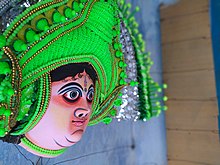Chhau mask
| Purulia Chhau mask | |
|---|---|
| Geographical indication | |
 Chhau mask of Charida, Purulia | |
| Alternative names | Chhau dance mask |
| Description | Chhau mask is used for Chhau dance in Purulia |
| Type | West Bengal folk cultural art |
| Area | Purulia and nearby villages |
| Country | India |
| Registered | 28 March 2018 |
| Material | Clay, soft paper, diluted glue, cloth, mud, fine ash powder etc. |
| Official website | ipindiaservices.gov.in |
The Chhau mask is a traditional cultural heritage of Purulia in the Indian state of West Bengal. The main difference between the Purulia Chhau dance and the Odisha Chhau dance is in the use of the mask. Purulia Chhau uses the mask in dance, but Odisha does not, thereby combining facial expression with body movement and gesture.[1] The Chhau mask of Purulia is registered on the List of Geographical Indications.[2] As the basic difference of Purulia Chhau the mask is unique and traditional.
History[]
The tradition of making Chhau masks started during the rule of king Madan Mohan Singh Deo of Baghmundi. The Chhau mask is traditionally associated with the age-old dance forms in (Purulia district|Purulia)
Theme and style[]

The mask used in the Chhau dance of Purulia is mainly for mythological characters such as Mahishasur-Mardini, Rama-Sita, the fight of Rama and Ravana, etc. Sometimes small Santhal couple masks are used. The mask has feathers and other ornaments that surround the face, which can be extended 2 feet from the mask itself. To portray Gods and Goddesses like Devi Durga, Lakshmi and Kartik the masks are coloured dark yellow or bright orange. The white colour is often used for lord Shiva, Ganesh and Devi Saraswati. Black or dark blue is used for Maa Kali. A tilak is generally used on the forehead of Krishna and Rama. The Asuras are painted in black or dark green with a thick moustaches, protruding teeth and large eyes.
Manufacture[]

Chhau masks are made by artists from the Sutradhar community. The making of a mask goes through various stages. 8–10 layers of soft paper, immersed in diluted glue, are pasted one after another on the mould before the mud mould is dusted with fine ash powder. The facial features are made of clay. A special layer of mud and cloth is applied and the mask is then sun-dried. After this, the mould is polished and a second round of sun drying is done before separating the layers of cloth and paper from the mould. After finishing and drilling of holes for the nose and eyes, the mask is coloured and decorated.[3][4]

Geographical Indications[]
The Chhau mask of Purulia is registered in the List of Geographical Indications in India.[5] As the basic difference of Purulia Chhau the mask is unique and traditional fact.
See also[]
- Chhau dance
- Arts of West Bengal
- Charida
References[]
- ^ "The Official Website of Purulia District". purulia.gov.in. Retrieved 2018-02-12.
- ^ "Bengal handicrafts to get new fillip with GI tags". The Hindu. PTI. 2016-08-16. ISSN 0971-751X. Retrieved 2018-05-15.
{{cite news}}: CS1 maint: others (link) - ^ "The Masks of Bengal" (PDF). static1.squarespace.com. Retrieved 2019-01-07.
- ^ "The Mask". Biswa Bangla. Retrieved 2018-02-12.
- ^ "Bengal handicrafts to get new fillip with GI tags". The Hindu. PTI. 2016-08-16. ISSN 0971-751X. Retrieved 2018-05-15.
{{cite news}}: CS1 maint: others (link)
- Culture of West Bengal
- Geographical indications in West Bengal
- Purulia district
